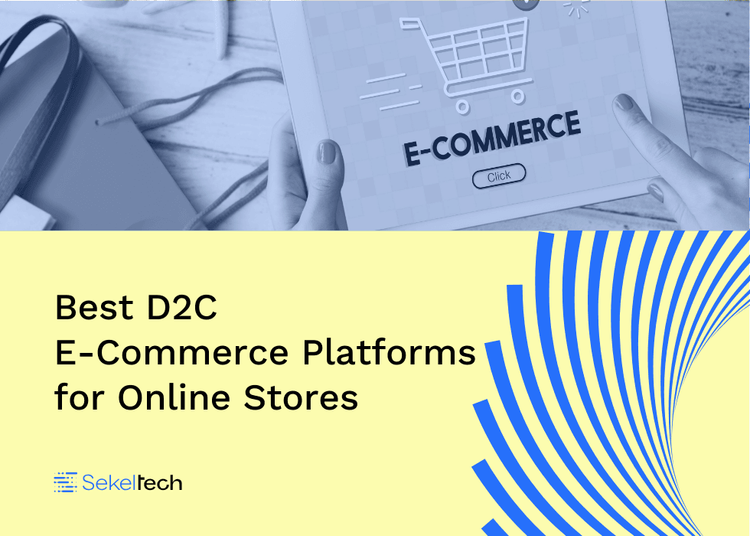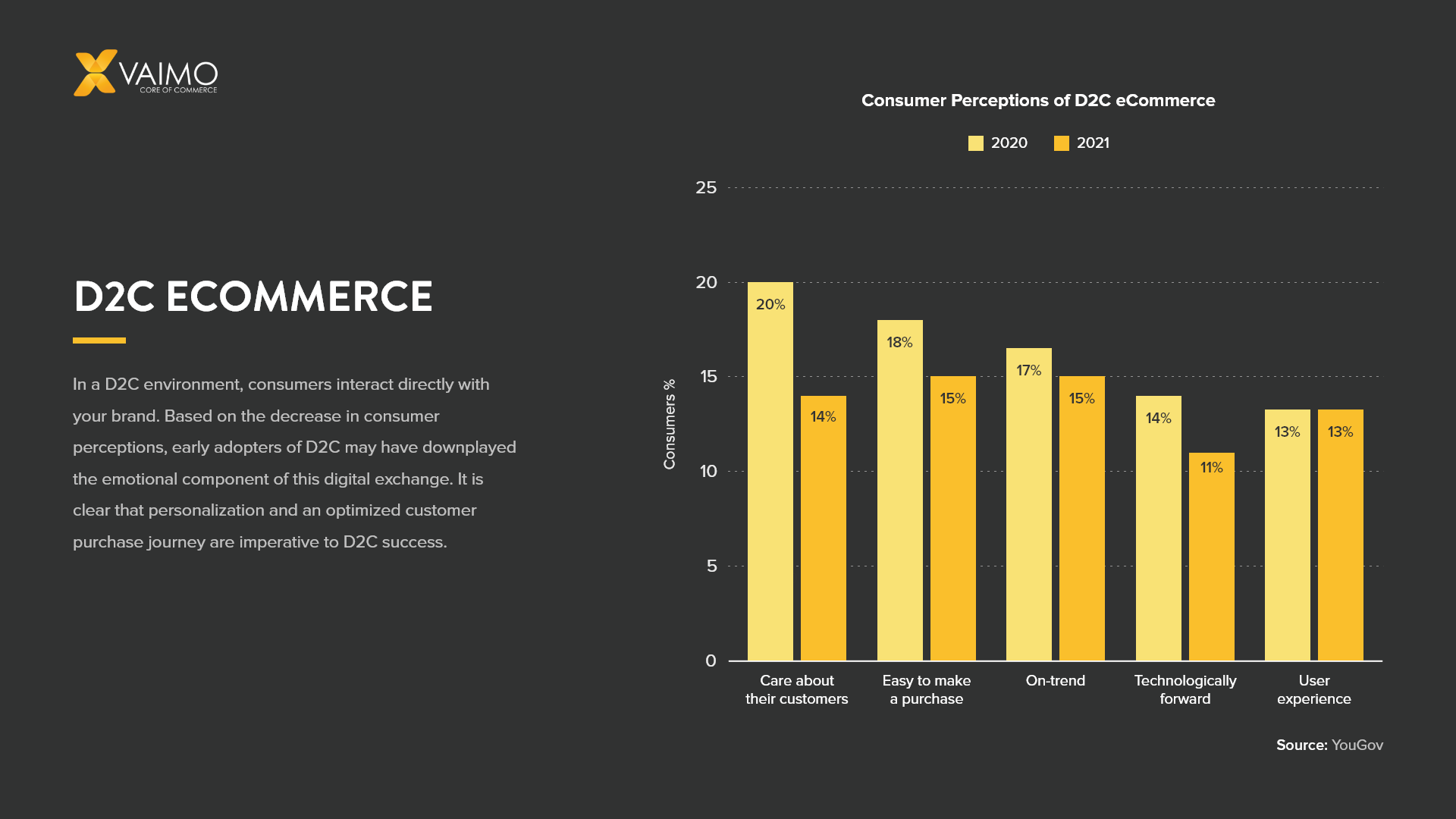Is a D2C Ecommerce Agency Worth It for Small Businesses?
Checking out the Potential of D2C Ecommerce: A Comprehensive Guide for Companies
The D2C ecommerce model provides a significant shift in exactly how brands involve with customers. It allows companies to bypass standard retail networks, cultivating deeper connections and possibly raised earnings margins. This approach is not without its complexities. Understanding the nuances of D2C ecommerce is essential for brands intending to thrive. What strategies can they embrace to browse this advancing landscape effectively? The solutions may redefine their organization techniques.
Comprehending the D2C Ecommerce Model

Key Perks of D2C Ecommerce for Brands
The D2C ecommerce version uses brand names substantial benefits, specifically relating to increased profit margins. By getting rid of intermediaries, companies can retain a larger share of sales income. Furthermore, this direct connection with consumers promotes boosted brand loyalty, encouraging repeat purchases and long-lasting involvement.
Boosted Earnings Margins

Boosted Brand Commitment
Building on the financial benefits of D2C ecommerce, improved brand name commitment becomes one more crucial benefit for firms involving straight with customers. By establishing a direct connection, brands can cultivate deeper connections with their clients, getting insights right into actions and choices. This direct communication enables more tailored advertising techniques, which resonate strongly with consumers. Additionally, brand names have the chance to control their messaging and customer experience, enhancing brand name worths and developing trust. When customers feel an individual connection, they are more likely to return, support for the brand name, and join community interaction. Eventually, boosted brand commitment not just drives repeat purchases but additionally cultivates an enthusiastic customer base, more solidifying a brand's position in the market.
Challenges Faced by D2C Brands
D2C brand names run into numerous considerable obstacles that can influence their success. Stock management issues can cause stock shortages or excess, complicating procedures and customer fulfillment. In addition, marketing spending plan restraints typically restrict the capacity to successfully reach and involve target market.
Supply Management Issues
Effective stock monitoring provides a powerful obstacle for lots of brand names running in the direct-to-consumer (D2C) room. These brands commonly face fluctuating demand, which can bring about overstock or stockouts, inevitably impacting client fulfillment and earnings. Furthermore, the lack of innovative inventory monitoring systems can result in discrepancies in between real stock levels and reported information, making complex order fulfillment. The diverse array of products D2C brand names commonly supply likewise makes complex supply administration, as variants in designs, sizes, and shades need even more thorough oversight. Numerous D2C businesses might struggle with restricted warehousing abilities, leading to inefficient use of room and sources. Reliable stock administration remains an important difficulty for D2C brands intending for lasting growth and operational effectiveness.
Advertising And Marketing Spending Plan Constraints
Steering advertising and marketing spending plan restraints is a significant difficulty for numerous direct-to-consumer (D2C) brands. Minimal funds typically limit these firms' capability to spend in all-encompassing advertising strategies, leading to minimized visibility in an open market. D2C brand names frequently grapple with the demand to take full advantage of roi (ROI) while targeting specific audiences effectively. This challenge is intensified by rising costs in digital marketing and the necessity to allot funds throughout several networks, consisting of social media, online search engine, and email advertising and marketing. Many D2C brands must introduce economical advertising and marketing remedies, leveraging natural growth techniques and influencer partnerships. Ultimately, effectively maneuvering these budget plan constraints is necessary for maintaining development and attaining long-term success in the advancing ecommerce landscape.
Approaches for Constructing a Successful D2C Ecommerce Service
As customers increasingly look for straight connections with brands, establishing an effective D2C ecommerce company calls for a tactical strategy that focuses on client interaction and depend on. One effective approach is to develop compelling brand name narratives that reverberate with target audiences, fostering psychological links. Utilizing social media platforms can improve visibility and assist in two-way interaction, permitting brand names to engage straight with customers.Moreover, individualized experiences through tailored marketing efforts can considerably boost customer retention and loyalty. Executing commitment programs and using unique bargains can additionally incentivize repeat purchases.Streamlining the buying procedure is necessary, making certain an user-friendly user interface that enhances the shopping experience. Additionally, transparent communication pertaining to delivery and returns builds trust and encourages consumer confidence.Finally, actively seeking client comments and reacting to it demonstrates a commitment to renovation and customer complete satisfaction, important components in the competitive D2C landscape.
Leveraging Innovation for Enhanced Client Experience
In today's competitive D2C ecommerce landscape, innovation plays a crucial role in shaping consumer experiences. Organizations progressively use advanced tools such as expert system, chatbots, and personalized formulas to enhance interactions and simplify the buying process. By integrating these technologies, brand names can give tailored item recommendations based upon private preferences and purchasing behaviors, fostering a more engaging experience.Moreover, responsive internet site designs and mobile applications guarantee that consumers can access solutions effortlessly across numerous gadgets. Enhanced repayment remedies, consisting of electronic wallets and one-click checkouts, further simplify purchases, making it less complicated for customers to make purchases.Data analytics click here likewise allows organizations to gather insights into consumer habits, permitting continuous improvement of offerings and services. In general, leveraging modern technology not just enhances client contentment but likewise grows commitment, ultimately driving lasting success in the D2C ecommerce industry.
Advertising And Marketing Techniques to Drive D2C Sales
Exactly how can brands properly catch the interest of consumers in a saturated market? To prosper in the direct-to-consumer (D2C) landscape, brands should use targeted advertising and marketing techniques. Utilizing social networks systems, brands can involve consumers via interactive material, influencer collaborations, and user-generated articles. Customized e-mail projects can likewise foster a sense of link, offering tailored promos based on consumer behavior and preferences.Moreover, narration plays a crucial role in distinguishing a brand's story, making it relatable and unforgettable. Brands ought to buy seo (SEO) to boost exposure, ensuring their products are easily discoverable online. In addition, leveraging data analytics allows services to refine their advertising and marketing approaches and comprehend customer patterns much better. Inevitably, a multi-channel strategy that incorporates creative thinking with data-driven insights can considerably enhance D2C sales, allowing brands to attract attention in a crowded market.
Future Trends in D2C Ecommerce
With the rapid advancement of technology and consumer choices, the future of D2C ecommerce is positioned for considerable makeover. Emerging trends indicate a shift in the direction of hyper-personalization, where brands leverage data analytics to tailor offerings to individual customer needs. This modification boosts client experiences, fostering loyalty and engagement.Moreover, sustainability is becoming a crucial element, with customers significantly preferring brand names that focus on green techniques - D2C Ecommerce Agency. Business are expected to embrace transparent supply chains and sustainable materials to fulfill this demand.The assimilation of expert system and increased reality will additionally change the purchasing experience, permitting consumers to envision products in their atmospheres prior to acquisition. Additionally, social business is expected to expand, as platforms like Instagram and TikTok promote seamless buying experiences directly within social media.These fads collectively indicate a vibrant future for D2C ecommerce, highlighting customer-centric strategies and cutting-edge modern technologies that redefine customer communications
Regularly Asked Inquiries
What Industries Benefit Many From D2C Ecommerce?
The existing concern highlights sectors that thrive through direct-to-consumer (D2C) ecommerce. Incredibly, style, beauty, electronics, and food industries leverage D2C versions to increase brand loyalty, improve client relationships, and enhance earnings margins efficiently.
Exactly How Do Shipping Expenses Influence D2C Rates Methods?
Delivering costs greatly influence D2C prices methods. Companies must balance these expenditures with affordable prices, considering customer expectations and revenue margins. Reliable management of shipping can enhance customer complete satisfaction and drive sales in direct-to-consumer models.
What Settlement Options Should D2C Services Deal?
D2C organizations ought to supply varied payment choices, consisting of credit/debit cards, digital pocketbooks, and acquire currently, pay later services. This range boosts customer comfort, boosts conversion rates, and satisfies various consumer preferences in the on-line buying landscape.
Just How Can D2C Brands Manage Consumer Returns Effectively?
D2C brands can deal with client returns properly by carrying out straightforward return policies, offering pre-paid delivery tags, and making certain timely refunds (D2C Ecommerce Agency). Clear communication and streamlined processes boost customer fulfillment and urge repeat service
What Legal Considerations Exist for D2C Ecommerce Workflow?
Legal factors to consider for D2C ecommerce operations include conformity with customer defense legislations, data personal privacy guidelines, copyright civil liberties, and tax requirements. Brands need to navigate these complexities to prevent lawful pitfalls and ensure smooth procedures. By getting rid of middlemans, D2C brand names can use affordable prices and foster an extra intimate connection with their customers.The D2C model is defined by its reliance on electronic systems, allowing brand names to use social media, online markets, and their very own websites to involve with customers directly. D2C ecommerce facilitates the collection of important client data, enabling brands to tailor their offerings and marketing strategies properly, inevitably driving sales and increasing margins. Furthermore, brands have the chance to regulate their messaging and consumer experience, reinforcing brand name worths and developing count on. As customers significantly seek straight connections with brand names, developing a successful D2C ecommerce company requires a strategic technique that focuses on customer involvement and depend on. D2C brand names can manage client returns effectively by implementing easy to use return plans, supplying pre paid shipping tags, and making sure punctual refunds.